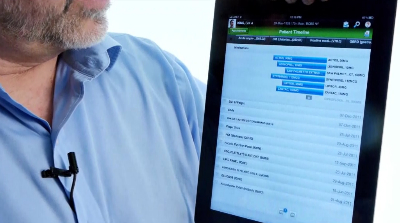 The iPad continues to be a hugely popular but imperfect tool for physicians, as suggested by two papers presented Monday at the American Medical Informatics Association (AMIA) annual symposium in Chicago.
The iPad continues to be a hugely popular but imperfect tool for physicians, as suggested by two papers presented Monday at the American Medical Informatics Association (AMIA) annual symposium in Chicago.
In two Fairview Health Services emergency departments in the Minneapolis-St. Paul area, physicians actually told IT leadership prior to the December 2010 go-live of an electronic medical record that they would not use the EMR unless they could access the new system on iPads. This "unique and interesting phenomenon," as one of the newly published papers put it, prompted University of Minnesota researchers to explore why.
"Any physician will swear by the fact that EMRs slow them down," said lead author Akhil Rao, a former Minnesota graduate student who now is a clinical analyst at HealthEast Care System in St. Paul. The doctors put a premium on workflow efficiency, and were convinced that iPads would make their jobs easier, he explained. In fact, 85 percent of the 14 emergency physicians Rao and his research partners interviewed – out of 22 total in the two EDs – already owned an iPad.
Three general themes emerged in the research: physicians expected iPads to improve their interaction with patients, make workflow smoother and provide "structural benefits" such as being easy to use and similar in format to paper. "The patient-physician interaction was paramount, of great importance to them," Rao said Monday. And having an iPad, the doctors believed, would make them look cutting-edge and improve communication.
Rao said that the average ED physician-patient encounter time is less than 8 minutes, so interactions need to be efficient. The iPad helps reduce redundancy because carrying a tablet with them means physicians do not have to log into a different computer in each patient room.
Some of the doctors also perceived that the iPad is good for infection control because solid-state tablets don't have fans that can blow germs around the room like PCs do. Physicians also said iPads are easy to disinfect. However, Fairview does not yet have evidence that either is true. "This was a preimplementation study so we don't know if the expectations were met," Rao said.
At Columbia University Medical Center in New York, researchers also studied physician perception of how iPads fit clinical workflow, but were more qualitative. The results were mixed.
Among 62 medical residents participating in the study, a majority answered clinical questions at the point of care on their iPads, but only 18 percent reported using iPads in clinical work daily, chiefly for reviewing documentation and lab results.
"Attending rounds was when house staff liked to use their iPads," said Columbia internist and postdoctoral fellow Dr. Colin Walsh. In fact, 90 percent of residents said they referred to their tablets while rounding with attending physicians. "That is the time physicians are truly mobile," Walsh said, because the residents could not step outside each room to use a PC.
Only 12.5 percent of Columbia house staff used iPads during patient handoff; after six months, the iPads did not replace paper at any point in the residents' workflow.
Walsh had hypothesized that tablets would free residents from fixed computers and give physicians more with patients and learning from faculty. "The reality is, they're spending a lot of time interacting with the electronic health record," Walsh said. "We got a very strong disagreement that tablets would allow them to spend more time at the bedside."
One of the problems, according to Walsh, is that Columbia installed a Citrix emulator requiring two logins, one for the Eclipsys EHR and a second for the Citrix app. Fairview ran into a similar problem with the Epic ASAP EHR module for emergency medicine, which was not tightly integrated with the iPad at the time of the implementation. (Epic Systems has since developed a native iPad app called Haiku.)
But both Walsh and Rao are convinced tablets are here to stay in EDs and inpatient wards. "It's one step closer to their ideal workflow. It's better to have something rather than nothing," Rao said.












